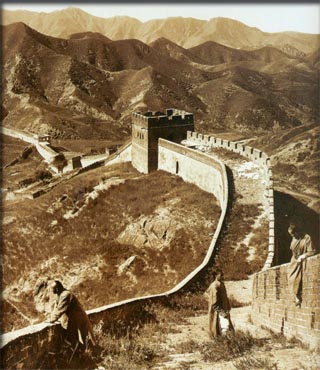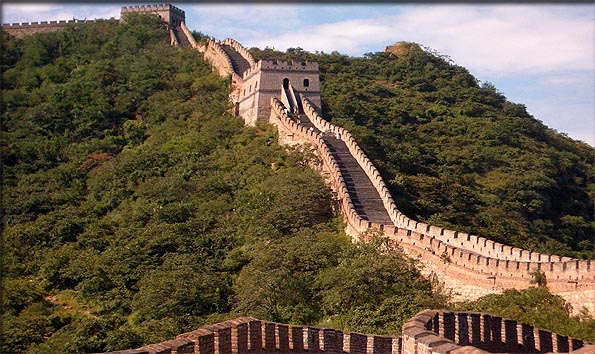 |
The
Great Wall of China
|
In legend,
the Chinese dragon is quite a bit different than the European
dragon. The mythical European drake is an evil beast with huge
wings that makes a sport of capturing beautiful maidens, roasting
courageous knights and guarding hordes of treasure kept in his
cavern-like lair. The Chinese dragon is quite unlike this. He
is both good and wise, has no wings, but instead a long, snake-like
body. He lives beneath the rivers of his homeland which he guards
from intruders.
Of course,
there is no such thing as a European dragon. However, in China
there is something that for hundreds of years has let its long,
snake-like form lay across the Asian countryside defending it
from outsiders. Many writers have indeed likened this thing
to a dragon. Most people, however, call it the Great Wall of
China.
|
Seven
Quick Facts
|
| Height:
16-26 feet (5-8m). |
| Width:
20 feet at bottom, 16 feet at top
(6 - 5m). |
| Length:
3,890 miles (6,259 km) of wall;
5,500 miles (8,851 km) including other types of barriers. |
| Built:
Construction started
about 1450 AD. |
| Location:
Along the border between ancient
Ming China and Mongolia. |
| Constructed
of: Mostly brick with
stone used in the foundations, gates and other sections. |
| Other:
Legend has it that it
can be seen by the naked eye from the moon, but this is
false. |
Early
Walls
The
Chinese have a long history of using walls for defense. As far
back as the eighth century BC, the warring states of Qin, Wei,
Zhao, Qi, Yan and Zhongshan built defensive structures around
their land to try and secure it from their neighbors. When Qin
Shi Huang conquered these kingdoms in 221 BC, however, he had
the walls between the old states torn down except those along
the northern frontier of his new empire. These he had extended
in an attempt to keep out invaders.
This
early wall was constructed of whatever materials were at hand.
In the mountains stone was used, while across the plains the
wall was made of "rammed earth": a mixture of sand, clay and
soil compacted between wooden frames and allowed to dry and
harden.
Today
nobody knows the exact course or length of this early wall,
but it was maintained and extended by some of the succeeding
dynasties. Portions of it may even have been incorporated into
the wall that stands today.
The
Great Ming Wall
On September
1, 1449 AD, a Ming Dynasty force 500,000 strong lost a decisive
battle to a much smaller army of Mongols from the north. The
capture of Empirer Zhengtong in the defeat nearly triggered
the collapse of the Ming government.
This
incident prompted the Ming Dynasty to decide to build a new
defensive wall along the northern border just south of the Ordos
Desert. It is this wall, when it was completed, that would become
known as the Great Wall of China. In the end the wall proper
would stretch 3,890 miles (6,259 km). When other barriers, like
trenches, rivers and hills are added in, the total length of
the defensive line comes to 5,500 miles (8,851 km). When finished,
the wall ran from the city of Qinhuangdao in the east, to Lop
Lake in the west.
The
construction done by the Ming Dynasty utilized brick and stone
rather than rammed earth. This speeded erection of the wall
and made it more resistant to damage from rain and snow. The
size of the wall differs depending on its location, but on average
stands between 16 and 26 feet in height (5 - 8 m) and is 20
feet (6 m) wide across at the base. The wall tapers inward so
that at the top it is only about 16 feet wide (5 m). The wall
is actually two outer walls constructed of brick and stone.
The area inside this was filled with loose stones, rubble and
earth. On top of this, between the battlements, a smooth path
was laid so that the crown of the wall could act as a road.
This allowed messengers and troops to move quickly across even
very rough terrain.
Can
You See It from Space?
As
far back as 1784, people have claimed that the Great
Wall was the only man-made structure that could be seen
from the moon by the unaided eye. This, however, is
clearly false.
The question of whether it can be seen from low orbit
is something that is still debated. Various astronauts
believe they seen it with the naked eye, but on at least
one occasion what the individual actually observed was
a river. It is clearly visible with binoculars, however
|
The
wall was not just a wall, but a series of fortifications including
watch towers, guardhouses, castles, gates and forts. In total
about 25,000 such defensive structures supported the wall. Typically
every 11 miles (18 km) a beacon tower was built into the barrier.
This allowed fire or smoke signals to pass information, such
as news of an impending attack, quickly along the wall from
fortification to fortification. This, in turn, would allow commanders
to move troops quickly to where they might be needed.
Attacks
Against the Wall
The
wall first protected against Mongol raids and later, starting
from about 1600, attacks from the Manchus from northeastern
China. The wall was not always a successful defense, however.
In 1550 the Mongol leader Altan Khan simply went around the
wall. The Manchus crossed the great wall in 1644 when the gates
at Shanhaiguan pass were opened by a Ming General who hoped
the invasion would quell a rebellion in the capitol city of
Beijing. The Manchus quickly took control of the Chinese heartland,
however, and brought the Ming Dynasty and any further work on
the wall to an end. The Qing Dynasty, which followed the Ming,
annexed Mongolia into the empire, alleviating the need for a
defensive line along that border.
|

The
wall as it appeared in 1907.
|
In the
16th century explorers and merchants from Europe began to visit
China and reports of the grandeur of the wall made it back to
Europe. An early description of the wall appears in João de
Barros' book Asia, which was published in 1563. The first
European to actually pass through the wall may have been the
Portuguese Jesuit brother Bento de Góis, who entered by the
northwestern gate from India in 1605.
The
Restored Wall
With
its purpose gone, the Great Wall was allowed to deteriorate
and parts of it were even disassembled for building material.
During the Cultural Revolution of the 1960's, the Communist
leaders turned against this symbol of China's majestic past
and destroyed much of the structure. Since 1984, however, the
government has taken an interest in preserving the wall and
using it as a symbol of the country. Large sections, especially
near tourist centers, have been restored. In 1987 The Great
Wall was declared a UNESCO World Heritage Site.
Today,
this sleeping dragon still snakes across much of the land, crossing
valleys and topping mountains. Like China itself, despite the
adversity it has seen, it has endured throughout the centuries.


Copyright
2012 Lee Krystek. All Rights Reserved.